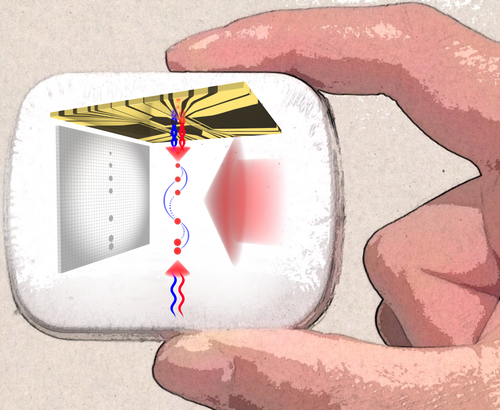Measuring Gravity with an Atom Chip
Geophysicists measure gravity with high precision to search for underground mineral resources or to detect small tectonic movements. A new compact gravity-sensing device, or gravimeter, uses a cloud of ultracold atoms trapped with lasers and magnets on a centimeter-wide “atom chip.” When released from the chip, the atoms fall through a laser field that routes them along two separate paths. The interference of atoms traveling these two paths provides a measure of gravity. With further improvements, this device could be carried in a small backpack to remote locations.
Atom interferometry has become a powerful tool for measuring gravity or rotation (see Focus: A Better Quantum Gyroscope). Atoms in a small cloud are cooled to near absolute zero, so that their quantum wave nature becomes observable. Lasers send the atoms along two paths that are like the arms of a light interferometer. When the paths merge, the interference between the atoms’ wave functions depends on the gravitational acceleration they experienced. Current techniques can measure gravity at a particular location with an uncertainty of a few parts in 109.
One way to improve on atom-based gravimeters is to squeeze the atoms together until their wave functions begin to overlap, resulting in a so-called Bose-Einstein condensate (BEC). The main advantage of using a BEC is that its diameter in the typical experiment is between 10 and 100 micrometers, which is about 100 times smaller than the usual non-BEC cloud of cold atoms. The smaller size means that the BEC is less affected by the nonuniform cross section of laser pulses used to manipulate the atoms.
Ernst Rasel of the Leibniz University of Hannover (LUH), Germany, and his colleagues have designed a gravimeter that uses a BEC made of rubidium atoms. Previous BEC-based gravimeters have been large, non-portable machines [1]. This new device takes advantage of atom-chip technology [2], which uses lasers and magnetic fields to trap atoms near the surface of a finger-nail-sized chip. The team’s atom chip, oriented horizontally inside a small, evacuated container, traps and condenses 10,000 atoms, creating a BEC within 15 seconds at a point just below the chip’s surface. When the atoms are released, they fall through a 1-cm-long region in which the interferometry is performed.
The interferometry steps are performed by a series of light pulses from an upward-aiming laser situated below the release point. The first pulse gives a momentum kick to atoms, but with only 50% probability. So this pulse creates two paths—one with a momentum kick and one without—between which the atom wave functions are split. Additional pulses deflect the atoms slightly, so that when they fall to the bottom of the interferometer region, the two paths meet and produce interference. The path with the extra kick is a bit longer, and this extra distance, which depends on the gravitational acceleration, is encoded in the measured interference pattern.
For a single fall, the time between the initial splitting pulse and the final recombining pulse is only 10 milliseconds. To increase this time, the team devised a “relaunch” mechanism—a laser pulse that catches the BEC at the bottom of its descent and shoots it back up to near its starting point. By performing the initial splitting pulse right after this relaunch and letting the atoms complete a full up-and-down trajectory, the interferometry time increases to 50 milliseconds.
By imaging the atoms at the end of their trajectory, the team can measure the acceleration of the BEC with a sensitivity of about one part in 107. Graduate student Sven Abend of LUH says that the team is working on improving the device by finding ways to suppress vibrations, which are currently the dominant source of uncertainty. The researchers believe that their compact scheme using BECs could eventually be incorporated into a shoebox-sized device that would measure gravity with an uncertainty less than one part in 109.
“This gravimeter indeed improves on previous gravimeter designs by using an atom chip,” says Franck Pereira dos Santos of the Paris Observatory. “This makes the design simple and compact, which is of importance for future field applications—in geophysics, for instance.” He cautions that some questions remain over the reliability of the laser-induced momentum kicks, but the technology is “definitely worth investigating.”
This research is published in Physical Review Letters.
Correction (14 November 2016): An earlier version of this article incorrectly stated the uncertainty of current gravity-measuring techniques. It is a few parts in 109.
–Michael Schirber
Michael Schirber is a Corresponding Editor for Physics Magazine based in Lyon, France.
References
- J. E. Debs, P. A. Altin, T. H. Barter, D. Döring, G. R. Dennis, G. McDonald, R. P. Anderson, J. D. Close, and N. P. Robins, “Cold-Atom Gravimetry with a Bose-Einstein Condensate,” Phys. Rev. A 84, 033610 (2011).
- J. Fortágh and C. Zimmermann, “Magnetic Microtraps for Ultracold Atoms,” Rev. Mod. Phys. 79, 235 (2007); M. Keil, O. Amit, S. Zhou, D. Groswasser, Y. Japha, and R. Folman, “Fifteen Years of Cold Matter on the Atom Chip: Promise, Realizations, and Prospects,” J. Mod. Opt. 63, 1840 (2016).





